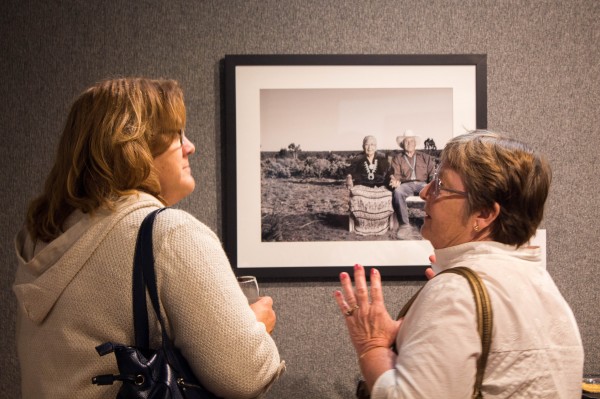
This week in the University Center Fine Art Gallery, works of art from Project 562 by Matika Wilbur are on display. Wilbur is a Native American photographer of the Swinomish and Tulalip tribes. I had the opportunity at her Artist’s Reception to speak with her on the project and hear her story of incredible inspiration and perseverance.
Project 562, which began in 2011, is a collection of photographs taken by Wilbur of Native Americans from the hundreds of tribes that exist in America. There were 562 tribes when Wilbur started the project but there are now 566. Her art aims to break the stereotypes that tend to be associated with Native Americans, like that they are vanishing.
“We are not vanishing,” said Wilbur. “We are thriving.”
Wilbur said she’s visited around 350 tribes in her three years of travel so far.
“In November, it will be the start of the fourth year,” Wilbur said. “I think I have about two years left, realistically. I was hoping to finish in three years but it’s not going to happen.”
Several of the photographs have black and white backgrounds with color specifically on the subjects or hints of color within them.
“I used to take pictures of people with plain backdrops because I love plain portraiture,” Wilbur said. “I mean genuine character study portraits where you really try to capture the essence and soul of a person. I decided for this project to photograph people outside in their natural environment because I think for a project of this nature, it makes sense to show the landscape as well because the landscape is also connected to our sense of self. [Where they come from] is equally important to telling the story. But in the beginning stages of my portraiture, I’m like, ‘but I want this to be more about the person than the whole thing. I want this to be a portrait.’ So then I started hand coloring them.”
Wilbur said she didn’t know how difficult the project was going to be when she started it.
“I knew it would be hard, but I’m well-traveled,” said Wilbur. “I’ve been all over the world, shooting on assignment for years, so I didn’t think that this would be much different. But to do this project, I first had to sell everything that I owned because I couldn’t afford to keep an apartment or a mortgage. I didn’t have a home base, so I had to stay with people at their houses and just keep going. Have you ever traveled long distances and then were excited about going home? You just want your own bed, you want a refrigerator with food in it that you like and you want to be around people that you know. So I had to learn to find identity not in the stuff that I owned, but in the person that’s inside that I carry with me.”
When she went to college, Wilbur didn’t want people to know she was a Native American.
“I was embarrassed,” she said. “When I would tell people that I was an Indian they would
assume that I was poor, that I came from drunks or that all Indians were dead. I got tired of fielding that question in college. I got tired of educating every person I encountered. So I stopped telling people that I was an Indian. I didn’t want to work in Indian country because I didn’t want the struggle of Indian country to be my struggle. So I pursued advertising, worked in LA and New York in fashion. I thought for sure that was the direction that I’d be going. Then I realized that industry wasn’t for me.”
Wilbur then got a job and moved to South America to photograph indigenous people there.
“Then I had a realization that I hadn’t worked with my own people,” Wilbur said. “So I came home and started photographing the elders of my tribe. So I had this collection of all these elders that I’d photographed and then my mom drug me into this art museum because they were having a big show. I didn’t want to go in because I was embarrassed since I didn’t want to show my portfolio to a big fancy curator. She told me ‘We’re going anyways,’ and drug me in there and so I showed my portfolio and the woman said, ‘I’d love to put your work up in a show.’ So I had an exhibition that led to another exhibition and pretty soon I was an artist, before I even knew it.”
After doing another project photographing descendants of a Native American boarding school, Wilbur decided to start Project 562.
In the course of Wilbur’s project, no one she has asked to photograph refused her.
“Everybody sees the need for it,” said Wilbur. “Everybody has felt the racism, the segregation, so they understand why the message needs to be shared. So they help, because they want it to be different for their children. They don’t want their children to experience the racism that they did. Racism is directly connected to perception. We have to ask ourselves why we feel afraid when we see people who are different than us. We have to check our fear and realize that it’s not coming from a truthful place. That fear was implanted in you. Somebody lied to you when they told you that you should be afraid of black people or when they told you that all the Indians are vanishing. So we have to go back into our memories to figure out when we agreed to believe those lies and erase them so we don’t treat people in a way that we don’t want to be treated.”
Project 562 will be at the FSU Fine Arts Gallery through Saturday, Sept. 26.
